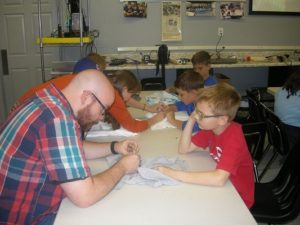
Matt Staggs has plenty of experience turning science lessons into engaging activities for students in Simpson County Schools.
As the science resource teacher who oversees the Exploratorium – a space dedicated to hands-on learning experiences that can get a bit messy – Staggs wasn’t terribly interested in showing Dianne Wade’s fifth-grade students from Lincoln Elementary School how electrical circuits work; at least not with the usual tools, such as wires and light bulbs, laid out on a table and connected to one another.
Instead, he taught the fifth-graders Monday about the workings of electrical circuits by showing them how to sew one into their clothes with conductive thread being used to connect a battery and a small LED light.
“I think it’s a little cooler because … I’m sure they probably mess around with wires and lit up a light bulb with a battery, but not many kids can say that they are actually wearing a circuit.”
During the exercise, students had T-shirts to which they attached small LED lights. Then, with guidance from Staggs and Wade, they attempted to connect the light to a silver, coin-shaped battery on the inside of the shirt with conductive metal thread sewn through the shirts.
The thread functioned as normal thread but had a rough texture. Unlike the wires typically used in elementary school circuit experiments, the thread wasn’t covered with rubber or any other insulator. It doesn’t carry a strong enough charge to make touching the thread dangerous, even when electricity is coursing through it, Staggs said.
“It’s only three volts,” he said. “It’s nothing too intense.”
The exercise was designed to test the children’s patience as well and teach the value of perseverance, Staggs said.
“A lot of the times, we learn from our mistakes,” he said. “You seem to retain things more from experience and not just positive experience but negative experience.”
Comparing the exercise to burning oneself on a hot oven and learning not to touch it again, Staggs said the difficulty of completing the circuit will give the students a better understanding of how electricity works.
“The kids know that their circuit will short out when two wires touch. We could tell them that all day long, but they don’t understand the significance of why is that important until they struggle with it and try and find a way to get the two wires to cross without actually touching,” he said.
During the exercise, many students were noticeably frustrated as they struggled to guide the thread through a small loop attached to the battery or to lead the thread through the fronts of their shirts.
At one point, Staggs told the students that he would come to their class soon so that he could help them finish their light-up shirts, something that was not originally planned.
Jack Morgan, who brought a shirt bearing an image of the poster for the original “Star Wars” movie and put a red LED in the triangle covering Darth Vader’s mouth, said he was having trouble connecting the thread to the battery, mainly because of the small size of the thread and the hole through which he had to maneuver it.
Despite the trouble he and his classmates had, Morgan said he felt that he understood the basics of electrical circuits, which Wade had not taught them about before the exercise.
“It’s been kind of challenging but if you can listen to (Staggs), then you can understand what he’s saying,” he said.
A few tables away, Gavin Link said that despite the difficulties of the project, he learned the importance of “how it flows through metal and you can’t make it in a circle but not connect it.”
Link and several of the other boys sharing the table with him said they were still excited about having a shirt with a working light in it and finishing the project.
Many students called for help on the project, and much of Wade’s and Staggs’ time through the 21/2-hour session was spent moving from one table to another helping them attach the thread to the lights and batteries and sewing the thread through the shirts.
Though they were often frustrated during the process, Wade said the students understood circuits because of the time they spent trying to get them to work.
“Part of the experience was for them to get frustrated and struggle through something,” she said. “We want them to develop perseverance.”
She said she’s used the Exploratorium previously and thinks the hands-on activities are beneficial because it provides a more direct way to work with the concepts they’ve learned.
“It gives kids a chance to put into action what they’ve learned,” she said. “It’s just a good way to tie in their learning with real-life experience.”


















